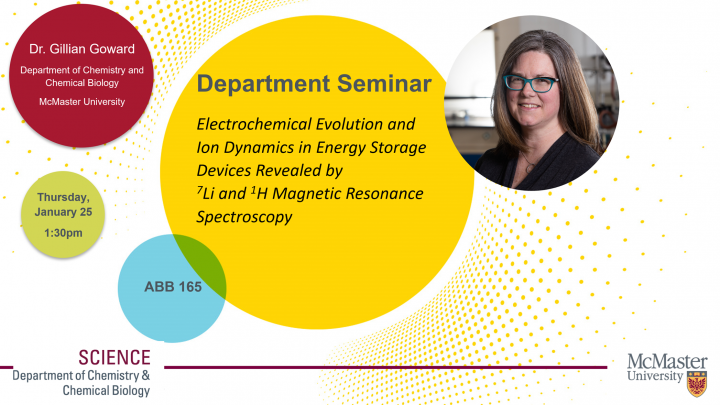Department Seminar: Dr. Gillian Goward
Jan 25, 2024
1:30PM to 2:20PM

Date/Time
Date(s) - 25/01/2024
1:30 pm - 2:20 pm
Title: Electrochemical Evolution and Ion Dynamics in Energy Storage Devices Revealed by 7Li and 1H Magnetic Resonance Spectroscopy
Date: Thursday January 25, 2024
Time: 1:30-2:20pm
Room: ABB 165
Host: Dr. Alex Adronov
Abstract:
Li-ion batteries (LIBs) have become ubiquitous in society; however, improved capacity of LIBs requires increased energy density, achievable through new choices of electrode materials. Beyond mobile devices, electrification of our energy consumption requires appropriate energy storage for the grid, for which LIBs are impractical. Alternative chemistries are composed of abundant materials and utilize aqueous electrolytes, which are environmentally friendly, sustainable, and cost-effective. Magnetic resonance spectroscopy and imaging techniques are powerful tools for probing dynamic processes in lithium-ion batteries.[1] We have recently reported the application of a parallel-plate resonator to the real-time 7Li operando NMR monitoring of Li metal deposition on a graphite anode during repeated charging and discharging of a single layer prismatic cell.[2] The method allows the quantification of the lithiation of the anode material as well as the early detection of plated metallic lithium throughout the duration of cell charging.[3] Moreover, the assessment of residual plated lithium as compared with plated lithium that can be absorbed during constant voltage holds provides valuable new information regarding the performance of charging protocols. The derivative operando (dOp) method[4] provides excellent visual information regarding the changing speciation in the cell. We have developed an add-on tool to be incorporated with the ssNAKE NMR software program,[5] which enables efficient deconvolution and quantification. Optimized 1H and 7Li PPRs are utilized to enable high sensitivity in situ and operando NMR experiments with fine temporal resolution, allowing identification of transient species such as Mn2+(aq) dissolution, and accumulation of defect sites.
[1] Pecher, O., Carretero-Gonzalez, J., Griffith, K., Grey, C.P., Chem. Mater., 2017, 29 213?242. DOI.org/10.1021/acs.chemmater.6b03183
[2] K.J. Sanders, J.R. Keffer, A.R. Aguilera, B.J. Balcom, I.C. Halalay, G.R. Goward Carbon 2022,189 (377-385) DOI.org/10.1016/j.carbon.2021.12.082
[3] K.J. Sanders, A.Czieki, A. Berno, I.C. Halalay and G.R. Goward, JACS 2023, (145 21502-21513) DOI.org/10.1021/jacs.3c07339
[4] Lopez, J.L.L., Grandinetti, P.J., Co, A.C., J. Mater. Chem. A, 2018, 6, 231–243. DOI:10.1039/c7ta07521a
[5] van Meerten, S.G.J., Franssen, W.M.J., Kentgens, A.P.M., J. Magn. Res., 2019, 301 56-66. DOI.org/10.1016/j.jmr.2019.02.006
